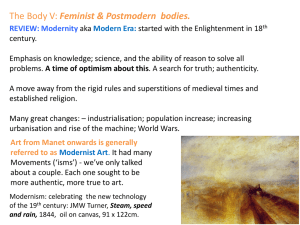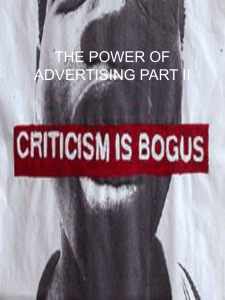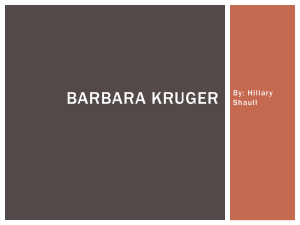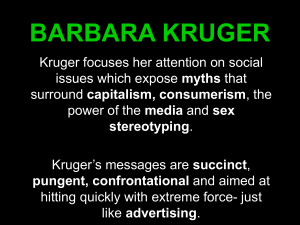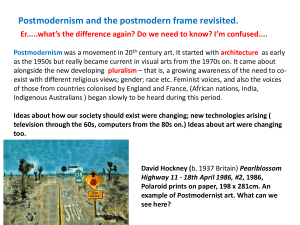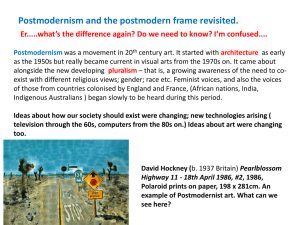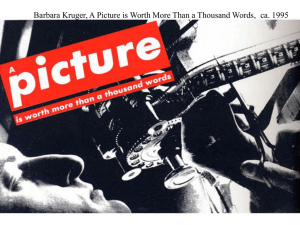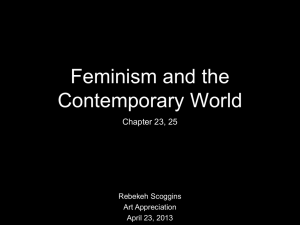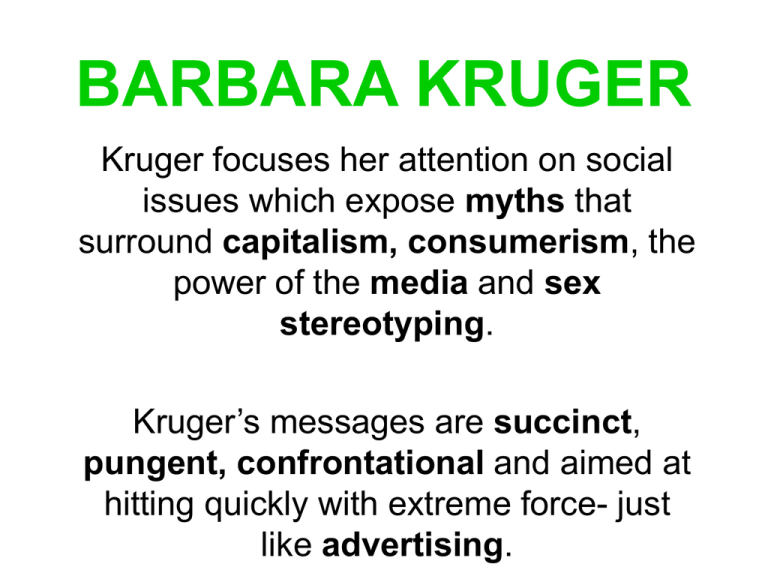
BARBARA KRUGER
Kruger focuses her attention on social
issues which expose myths that
surround capitalism, consumerism, the
power of the media and sex
stereotyping.
Kruger’s messages are succinct,
pungent, confrontational and aimed at
hitting quickly with extreme force- just
like advertising.
We don’t need another hero
Barbara Kruger, 1986
Compare to – Norman
Rockwell The Muscleman
1941
• Iconography – what does a clenched
fist and displayed bicep represent?
• How does this work address gender
stereotypes?
Barbara Kruger
• Born in New Jersey in 1945.
• Often described as a
'social commentator and
a political agitator'
• Worked early in career as a
graphic designer, art
director and picture editor.
• Kruger’s artworks appear in
museums and galleries on
billboards, bus cards,
posters, parks, signs,
train platforms and various
other public places making
her work highly accessible
to all (not just us art folk).
Barbara Kruger
• Trademark black letters lay
against a slash of red
background.
• Instantly recognisable
slogans which challenge
and test her viewers.
• Easy to identify with- using
relevant issues of
contemporary society
throughout her works.
• Hard not to provoke personal
and ‘real’ discussions with its
audience.
• Comment on the woman’s
role in this work who has
been ‘put in place’ by
another…
Barbara Kruger
• Confronting, demanding
and persuasive text.
• Gives viewers a sense of
promise and/or hope, yet
we are not actually told
what we are purchasing.
• Relaying that
consumerism and has the
power to simply ‘change
the world’
• Kruger installs instant
hope within ourselves- till
we soon realise that we
have just been tricked by a
master of her craft.
• Comment on how Kruger has used
recognisable slogans from our society to
provoke both interest and outrage from her
audience about gender roles and equality…
Binary
oppositions
MAN
WOMAN
SELF
OTHER
CULTURE
NATURE
ACTIVE
PASSIVE
SUBJECT
OBJECT
SURVEYER
SURVEYED
DOMINANT
SUBMISSIVE
REASON
EMOTION
PUBLIC
PRIVATE
Kruger is interested in DISRUPTING
these binary oppositions that form the
basis of many of our gender
stereotypes
Untitled (We won’t play nature to
your culture) 1983
Context: from 1970s to 1980s
Feminism
• Backlash against Feminism from the Right
• 1980s – Gender studies in US universities but
gender bias in galleries is actually worse than
in 1970s
• Rise of Postmodernism pluralism,
deconstruction , identity politics – the idea that
being a woman is socially constructed
• In art appropriation of images, increased
use of language
Your gaze hits the
side of my face
• Iconography:
comment on
Kruger’s choice of
image
• Composition: why
is the text laid out
like this?
• What feminist
concerns come
through?
• ‘You invest in the
Divinity of the
Masterpiece’
• What image has
Kruger
appropriated?
• What is the feminist
message of this
work?
• Comment on the
composition
What big muscles you have!, 1986 152,5 x
208 cm, Centre Pompidou, Paris.
“cogito ergo sum”
Rene Descartes
Consumerism
& Capitalism
•How does Kruger manage to blur the
boundaries between high and low art
here?
- In what ways can this work be seen to
offer a critique of consumerism and
sexism?
TEXT
• Kruger layers famous
photographs which her
audience are often
familiar with, with cutting,
biting and aggressive
text that involves the
viewer in the struggle for
power and control that
her captions speak to.
• Kruger wishes to change
the way society looks at
and reads images which
are presented to them,
Kruger wants us not to
take her work just on face
value.
• Do actions speak
louder than words???
SLOGANS
• Kruger includes well
known slogans to draw
in her viewers.
• Consumerism is present
in Kruger’s work as she
explores themes of
greed, self-indulgence
and manipulation.
• Kruger chooses to use
only b+w in the
background as she
wishes for her text to be
seen first-- from this we
gain an impression
which is then, often
What does this artwork say about
consumerism defining ones’ self?? changed by the image
that follows.
Political Controversy
• Kruger’s work is often
politically based and
highly controversial at the
time of print.
• Comment on the use of
American President
George Bush in this
work.
What do you think the
words Kruger has
included into the image
are implying??
• What is the reference to
war??
•
•
•
•
•
Feminism
Kruger was highly influenced by
the feminist movement in
America.
Kruger was regularly fighting for
equal rights and opportunities in
her confronting compositions.
Kruger allowed this image to be
displayed on postcards and flags
with the added text "Support
Abortion, Birth Control, and
Women's Rights” during a prochoice rally in Washington D.C
during election month.
Kruger wanted to make a
political statement about
abortion is this work, explain
how she has achieved this??
What do you think the word
‘battleground’ implies in this
context??
Kruger’s aims and concerns
Kruger’s art work in the public sphere:
What is the effect of the juxtaposition of these images?
In what way can using a public media site (billboard) be seen as a postmodernist and/or feminist strategy?
Gender Roles
• Marilyn Monroe- the most
beautiful woman of all
time, thought to be the
perfect, ideal woman.
• Women wanted to be her,
men wanted to be with
her.
• Actress- linked to famous
men including JFK.
• Coined the term ‘Blonde
Bombshell’
• What do you think the
text is trying to say in this
artwork about women
and their role in society?
ART
• Recontextualisation of infamous
artwork by Michelangelo.
• Focusing attention on moment of
creation- the touch.
• Text is placed over the quoted
masterpiece, thus obscuring it and
dominating it. Kruger parodies the
work of Michelangelo by imitating it
in a fashion that ridicules its
authority, power and extreme
beauty.
• Comment on the use of the words
‘invest – divinity - masterpiece’ in
this appropriated artwork..
Double Meaning
• Kruger often exposes us to an
aesthetically pleasing image with a
hidden under text.
• Kruger simply does not want to
give us the meaning of her work.
She wants to challenge us, to
provoke interest for us to question
her method- Essentially how we
translate Kruger’s compositions is
up to our own experiences,
knowledge and personal
interpretation.
• This composition uses a mirror and
one’s reflected image. By looking
at the image and text separately
explain how this artwork is a
obvious contradictory…
Installations
• Installations provide their
audience with the opportunity to
be totally immersed within an
artwork.
• Very confrontational.
• What does this artwork scream
as a first impression??
• What impact would the use of
all walls, strong colours,
emotional faces and bold text
in this installation have on its
audience??
• What makes an installation
more powerful than a 5x7
APPROPRIATIONUse of another’s
work in a new
context with no
intention of altering
its meaning /
visual impact in a
way that both
recognises and
subverts the
authority of the
original.
PARODYThe imitation of
someone or
something in a way
that ridicules or
makes fun of them
PASTICHE
Work consisting of
motifs borrowed from
multiple sources often
with mixed styles or
appropriations from a
number of well-known
artworks.
IRONYLiteral meaning is the
opposite to the
intended meaning,
often in a playful or
satirical manner.
TRANSGRESSIONAn act which goes
beyond set rules,
beyond the limits.
Homework - Post Modern
• Look through newspapers or magazines and find an A4
image which you think has a strong message that you
could appropriate. Eg) smoking, drink driving, skin
cancer, plastic surgery, cruelty to animals etc.
• Cut out this image and stick it in your sketchbook
• Now start brainstorming for original slogans which could
single-handedly destroy your images message.
• Once you have decided on a slogan you must place it
upon your image creatively .
• Once complete you must use some form of technology
to hand in your work to your teacher eg) photo,
scanned copy, photoshop image etc – be creative and
remember- make it humorous. Good Luck…

